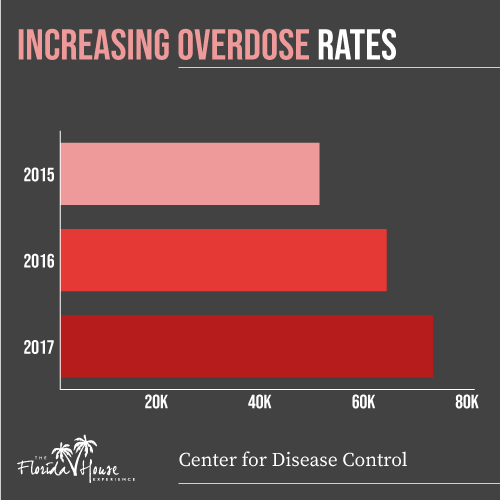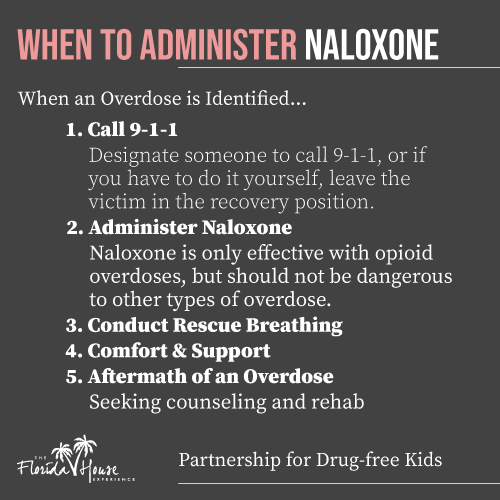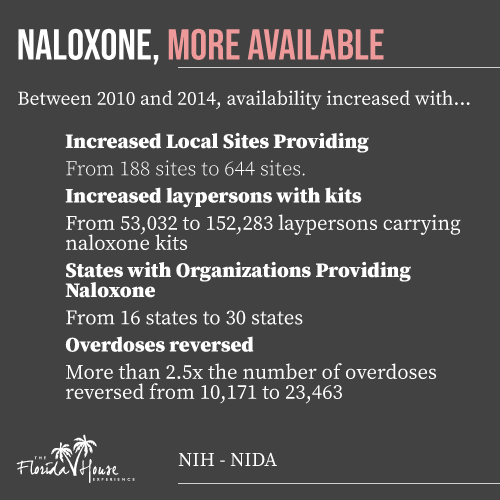
The opioid epidemic has reached critical proportions, affecting populations across virtually all demographics in the United States. The year 2016 alone saw over 63,000 opiod overdose deaths, an increase of 21.5 percent over 2015. With an estimated 72,000 deaths in 2017, this trend is only worsening, putting more lives at risk with few signs of progress. In fact, the rise of the opioid epidemic may be contributing to a reduction in life expectancy in the United States; a child born in 2018 can expect to live to age 78.6, a decrease from 78.7 in the prior year.
However, those on the front lines of the opioid epidemic have one critical, valuable tool available: naloxone, an easy-to-use medication that has the power to reverse opioid overdoses before it’s too late.
Need Help?
Treatment can begin quickly and discreetly, get started now
What Is Naloxone?
 Naloxone is an opioid antagonist, or a substance that binds to opioid receptors in the body. When given to those experiencing an opioid overdose, use of naloxone can reverse and block the effects of opioids within the body, negating symptoms like respiratory and circulatory failures. For this reason, police officers, EMTs and other emergency responders often carry naloxone to administer to those who may be experiencing an opioid overdose.
Naloxone is an opioid antagonist, or a substance that binds to opioid receptors in the body. When given to those experiencing an opioid overdose, use of naloxone can reverse and block the effects of opioids within the body, negating symptoms like respiratory and circulatory failures. For this reason, police officers, EMTs and other emergency responders often carry naloxone to administer to those who may be experiencing an opioid overdose.
Naloxone has very few side effects when used, making it a safe opportunity for those overdosing on opioids. For those who have not taken opioids, naloxone is still safe for use, offering no discernable consequences. As such, first responders are encouraged to use naloxone in any instance that could possibly be an overdose.
Begin your recovery today
Ready to start? More questions about treatment?
How to Use Naloxone for an Opioid Overdose?

When using naloxone on someone who may be overdosing from opioids, it’s very important to notify emergency personnel as soon as possible. As naloxone only stays in the body for 30 to 90 minutes, someone who appears to come back from an overdose may require further medical attention when naloxone wears off.
Naloxone is available in several forms and is generally easy to use by those with and without training.
Injectable Naloxone
Injectable naloxone is sold in vials and requires a syringe for use. In general, injectable naloxone is only recommended for those who have medical training.
Autoinjectable Naloxone
Due to the increase in use among those without medical training, the FDA has approved Evzio, an autoinjector intended for those who do not have training in using syringes for medication administration. When activated, Evzio works in a way similar to an automated defibrillator, providing spoken instructions to ensure safe and proper use. Evzio is packaged as a double dose, in case a single dose is not enough to reverse symptoms.
Nasal Sprays
Naloxone is also available as a nasal spray known Narcan. A prefilled device that doesn’t require the use of needles, Narcan allows administration through the nostrils. Like Evzio, Narcan is sold in a double dose for use in severe cases.
Between 1996 and 2004, over 26,500 potential overdoses were reversed by laypeople using naloxone on friends, family members, and acquaintances.
More Questions about Treatment?
We offer 100% confidential and individualized treatment
How Can You Obtain Naloxone for Opioid Overdoses?

Start Treatment Now
Treatment can begin quickly and discretely, get started now
What are the Benefits of Naloxone in Opioid Recovery?
Naloxone has the potential to reverse an overdose and prevent death, but it can also be a valuable tool in encouraging recovery for long-term users. Requiring a dose of naloxone can serve as a wake-up call of sorts, alerting users to an untenable situation that necessitates a change. For some, the near-death experience related to overdosing can be a sign of hitting rock bottom, indicating that it is finally time to seek treatment and stop the cycle of abuse.
While the rising rates of opioid overdose are deeply concerning, naloxone offers significant opportunity to prevent overdose deaths and help stabilize life expectancy rates. As availability improves, it is likely that naloxone use will continue to play a role in fighting back against opioid abuse.
About Chris Foy
Chris Foy is a content manager and webmaster for FHE Health with years of experience in the addiction treatment industry...read more






